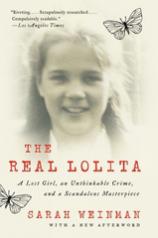Reading Group Guide
Discussion Questions
The Real Lolita: A Lost Girl, an Unthinkable Crime, and a Scandalous Masterpiece

1. Sally Horner encounters Frank La Salle at the Camden, New Jersey Woolworth’s at a critical moment in her life. Did you identify with her feelings of wanting to belong? Did you think the circumstances in which Sally grew up were a factor in what happened in March 1948?
2. THE REAL LOLITA describes American cities like Camden, Baltimore, Dallas and San Jose just after World War II, and neighborhoods about to go into economic decline. In the same way, LOLITA is often thought of as a tug of war between old-world Europe (Humbert Humbert) and new-world America (Dolores Haze). What does Weinman’s book have to say about America, and the way things have changed --- and how they haven’t?
3. Many people had the opportunity to help Sally Horner during her 21 months of captivity. What did you think of their choices, or lack of action? What might you have done in the same situation?
4. Sally’s mother, Ella, said on multiple occasions after her daughter’s rescue that “whatever Sally has done, I can forgive her.” Do you think Ella’s comment is a product of her time? What may have prompted her to think this way?
5. Ruth Janisch, the woman who engineered Sally’s rescue, is a complex, fascinating character. How can you resolve this “one decent thing” she did in her life with the way she treated her family, especially her daughters? How do we sit with the idea that people, women especially, may not look out for the best interests of those they love even as they bring about a momentous change in another person’s fortune?
6. On occasion, Weinman reveals what she hoped to find out about Sally Horner’s ordeal, and speculates on what Sally might have thought or felt at a given moment --- especially during the Baltimore period. What did you think of this technique? Did it make you trust Weinman’s authority as a storyteller more?
7. Upon returning home, Sally tried to resume her old life, despite the prosecutor’s advice to Ella that she and her daughter change their names and leave town. What did you think of Ella’s choice, and how it affected Sally? How did you feel when Carol described some of the remarks and insults Sally endured because her classmates did not understand she was a victim?
8. What responsibility does a fiction writer have to real-life source material? Did Vladimir Nabokov play fair by weaving Sally Horner’s story into LOLITA, or was his overarching philosophy that art must exist for art’s sake triumph above all?
9. THE REAL LOLITA arrives at a moment when American culture in particular is taking a close look at the ways in which we treat girls and women, what with the #MeToo movement. How does Sally Horner’s story, from 70 years ago, illustrate the issues we are still grappling with today?
10. Do you think LOLITA could be published in today’s cultural climate, or would it be too controversial? And what attitudes about Lolita immediately upon its American publication, and resonance with late 1950s culture, still remain?
11. If you have a child around Sally Horner’s age, do you think THE REAL LOLITA, and Sally’s story, is a good way to discuss difficult topics like kidnapping and child sexual abuse? How would you talk about what happened to Sally to your own child?
The Real Lolita: A Lost Girl, an Unthinkable Crime, and a Scandalous Masterpiece
- Publication Date: September 10, 2019
- Genres: History, Nonfiction, True Crime
- Paperback: 336 pages
- Publisher: Ecco
- ISBN-10: 0062661930
- ISBN-13: 9780062661937







